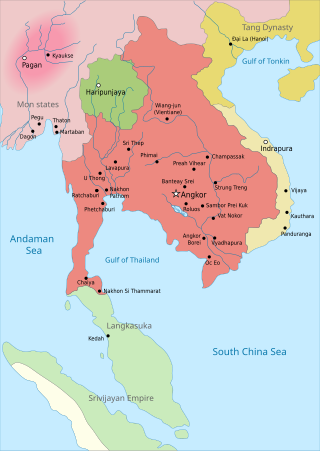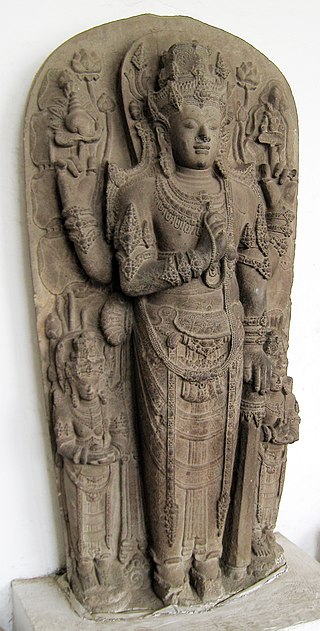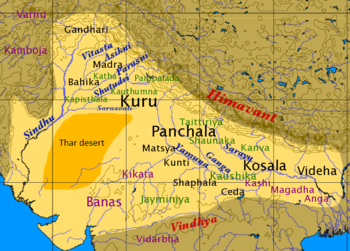
The Khmer Empire was a Hindu-Buddhist empire in Southeast Asia, centered around hydraulic cities in what is now northern Cambodia. Known as Kambuja by its inhabitants, it grew out of the former civilisation of Chenla and lasted from 802 to 1431. Historians call this period of Cambodian history the Angkor period, after the empire's most well-known capital, Angkor. The Khmer Empire ruled or vassalised most of mainland Southeast Asia and stretched as far north as southern China. At its peak, the Empire was larger than the Byzantine Empire, which existed around the same time.

Funan was the name given by Chinese cartographers, geographers and writers to an ancient Indianized state—or, rather a loose network of states (Mandala)—located in mainland Southeast Asia centered on the Mekong Delta that existed from the first to sixth century CE. The name is found in Chinese historical texts describing the kingdom, and the most extensive descriptions are largely based on the report of two Chinese diplomats, Kang Tai and Zhu Ying, representing the Eastern Wu dynasty who sojourned in Funan in the mid-3rd century CE.
The early history of Cambodia follows the prehistoric and protohistoric development of Cambodia as a country in mainland Southeast Asia. Thanks to archaeological work carried out since 2009 this can now be traced back to the Neolithic period. As excavation sites have become more numerous and modern dating methods are applied, settlement traces of all stages of human civil development from neolithic hunter-gatherer groups to organized preliterate societies are documented in the region.

Chenla or Zhenla is the Chinese designation for the successor polity of the kingdom of Funan preceding the Khmer Empire that existed from around the late sixth to the early ninth century in Indochina. The name was still used in the 13th century by the Chinese envoy Zhou Daguan, author of The Customs of Cambodia. It appears on the Mao Kun map. However, modern historiography applies the name exclusively to the period from the late 6th to the early ninth century. This period of Cambodian history is known by historians as the Pre-Angkor period. It is doubted whether Chenla ever existed as a unitary kingdom, or if this is a misconception by Chinese chroniclers. Most modern historians assert that "Chenla" was in fact just a series of loose and temporary confederations of principalities in the pre-Angkor period.
The Khmer people are an Austroasiatic ethnic group native to Cambodia. They comprise over 90% of Cambodia's population of 17 million. They speak the Khmer language, which is part of the larger Austroasiatic-language family found in parts of Southeast Asia, parts of central, eastern, and northeastern India, parts of Bangladesh in South Asia, in parts of Southern China and numerous islands in the Indian Ocean.

The Kambojas were a southeastern Iranian people who inhabited the northeastern most part of the territory populated by Iranian tribes, which bordered the Indian lands. They only appear in Indo-Aryan inscriptions and literature, being first attested during the later part of the Vedic period.

The Mahājanapadas were sixteen kingdoms or oligarchic republics that existed in ancient India from the sixth to fourth centuries BCE, during the second urbanisation period.

Arta was the elder brother of the well known Gandhara ruler Maues or Moga.
Shivi is mentioned as a kingdom and as the name of a king in the ancient Indian epic Mahabharata. There was a king named Shivi who became famous as Shivi or the kingdom itself may be named after him. Shivi king was famous for his truthfulness. The legend about his truthfulness and compassion goes as follows: King Shivi protected a dove who was chased by a hawk, and gave flesh from his thigh, as a substitute meal to the hawk.

The kingdom of Tushara, according to ancient Indian literature, such as the epic Mahabharata, was a land located beyond north-west India. In the Mahabharata, its inhabitants, known as the Tusharas, are depicted as mlechchas ("barbarians") and fierce warriors.
The Bahlikas were the inhabitants of Bahlika, mentioned in Atharvaveda, Mahabharata, Ramayana, Puranas, Vartikka of Katyayana, Brhatsamhita, Amarkosha etc. and in the ancient Inscriptions. The other variations of Bahlika are Bahli, Balhika, Vahlika, Valhika, Bahlava, Bahlam/Bahlim, Bahlayana and Bahluva.
The name of Cambodia in Khmer is កម្ពុជា, officially ព្រះរាជាណាចក្រកម្ពុជា. This term derives from Sanskrit कम्बोजदेश, which means the "land of Kamboja".
Jayavarman VI was king of the Khmer Empire from about 1080 to 1107 AD.
Dharmapala Kamboja was probably the last ruler of Kamboja Pala dynasty of Bengal. He ruled Dandabhukti-mandala in Vardhamana-bhukti in the first quarter of eleventh century and was contemporary of Rajendra Chola of Chola dynasty of Deccan.

The Silver Reliquary of Indravarman is an inscribed silver Buddhist reliquary dedicated by Apracaraja king Indravarman in the 1st century BCE, which has been found presumably in the Bajaur area of Gandhara. Believed to have been fabricated at Taxila, the silver reliquary consists of two parts—the base and the cover—both being fluted, and the cover being topped by a figure of long horned Ibex. It has been dated to around the eighth or ninth decades of the 1st century BCE and bears six inscriptions written in pointillē style, in Kharoshthi script and Gandhari/north-western Prakrit. In form, the silver vessel is wholly atypical of Buddhist reliquaries and is said to have been a wine goblet, similar to others found in Gandhara and Kapisa regions. The vessel was later reused by Apraca king Indravarman as a Reliquary to enshrine Buddhist relics in a stüpa raised by Indravarman. The inscriptions on the silver reliquary provide important new information not only about the history of the kings of Apraca dynasty themselves but also about their relationships with other rulers of the far north-western region of traditional India i.e. modern northern Pakistan and eastern Afghanistan around the beginning of Christian era.
The Kingdom of Kapisa was a state located in what is now Afghanistan during the late 1st millennium CE. Its capital was the city of Kapisa. The kingdom stretched from the Hindu Kush in the north to Bamiyan and Kandahar in the south and west, out as far as the modern Jalalabad District in the east.

"Devarāja" was a religious order of the "god-king," or deified monarch in medieval Southeast Asia. The devarāja order grew out of both Hinduism and separate local traditions depending on the area. It taught that the king was a divine universal ruler, a manifestation of Bhagawan. The concept viewed the monarch to possess transcendental quality, the king as the living god on earth. The concept is closely related to the Bharati concept of Chakravartin. In politics, it is viewed as the divine justification of a king's rule. The concept was institutionalized and gained its elaborate manifestations in ancient Java and Cambodia, where monuments such as Prambanan and Angkor Wat were erected to celebrate the king's divine rule on earth.
Īśānavarman or Yīshēnàxiāndài was a king of the kingdom of Chenla in 7th century, which would later become the Khmer Empire. He was the son of, and successor to Mahendravarman.

Kaundinya I, also known as Hùntián (混塡) and Preah Thong, was the second monarch of Funan which comprises much of Cambodia located in mainland Southeast Asia centered on the Mekong Delta. He was the consort of the first monarch Soma, Queen of Funan, also known as Liǔyè (Chinese) and Neang Neak (Khmer) and together both were the co-founders of the kingdom of Funan with the capital located at Vyadhapura.










